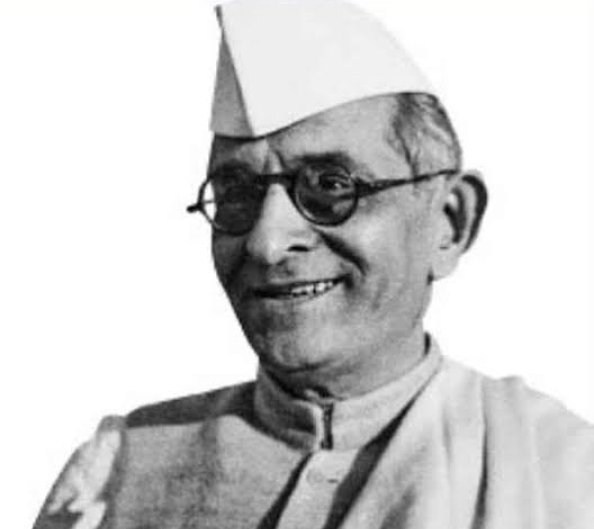The man who made sure the construction of Somnath temple.


K.M. Munshi, freedom fighter, founder of Bharatiya Vidya Bhavan, as well as the Vishwa Hindu Parishad. A lawyer by profession, he was also one of the foremost writers in Gujarati. And presided over the surrender of the Nizam post Operation Polo.
Thread on him.
Kanaiyalal Maneklal Munshi was born on December 30, 1887 at Bharuch, he graduated from the MS University in Vadodara, with honors. He later received his LLB from Mumbai University in 1910, and was a registered lawyer.
His professor at MS University was Shri Aurobindo who would have a great influence on his life. Among others who influenced him were Sardar Patel, Mahatma Gandhi, Bhulabhai Desai, and the Maharaja of Vadodara.
He initially was part of the revolutionary group in Congress under the influence of Aurobindo, even took part in bomb making. He however later joined the more moderate group, under influence of Surendranath Banerjee in 1920.
Though elected to the Bombay Legislative Assembly, he resigned after the Bardoli Satyagraha, and took part in the civil disobedience movement in 1930, and was arrested for 6 months. He was arrested again later in 1932.
Elected again in the 1937 Bombay Presidency election, he served as Home Minister, and during his tenure, managed to control the communal riots there. The reason why Sardar Patel later sent him to Hyderabad during Operation Polo.
One of the supporters of Akhand Bharat, he felt a non violent approach would be of no use to Hindus following the Direct Action Day, and the Muslim League attacks on Hindus in North West, as well as in Bengal.
It was after Independence that Munshi would play a crucial role in two princely states which had their own issues of accession to India- Junagadh and Hyderabad.
He would play a crucial role in the integration of Junagadh into the Indian Union, after it’s Nawab had fled to Pakistan along with his family. As also the reconstruction of the Somnath Temple.
While Sardar Patel started the reconstruction of Somnath after independence, it was Munshi who led the effort on the ground, and ensured it’s completion after the Sardar passed away, in the face of stiff opposition from Nehru.
His succesful handling of the communal riots in Bombay Presidency, made Sardar Patel appoint him as Agent General to Hyderabad State during Operation Polo,and it was Munshi who accepted the Nizam’s surrender.
The Nizam had actually refused to meet Munshi, and even put him under house arrest. And finally after Operation Polo, he had to surrender to him.
Munshi was also on the Comittee that drafted the Constitution, along with B.R. Ambedkar, and initiated the Van Mahotsav in 1950 to increase tree cover.
In 1959 however Munshi left the Congress party, and was one of the founders of the Swatantra Party, along with Rajaji, that had a true conservative policy, believing in free market, private property.
Munshi was also one of the founders of the Vishwa Hindu Parishad in 1964, along with Golwalkar, Chinmayananda, S.S.Apte, Keshavaram Shastri, to consolidate the Hindu society.
In many ways K.M. Munshi was one of the early Right Wing or Conservative political leaders in India, supporting free market, private property, as well as a more Hindu oriented outlook.
The Bharatiya Vidya Bhavan was established by Munshi on November 7, 1938 along with his wife Leelavati, that would promote the traditional knowledge along with the modern education, now one of the premier educational institutions.
He also established the Mumbadevi Sanskrit Mahavidyalaya to teach Sanskrit and ancient Hindu texts. He also founded the Bhavan’s College, Hansraj Morarji Public School, Rajhans Vidyalaya and Sanjeewan Vidyalaya at Panchgani.
As fellow of University of Bombay, he ensured adequate representation to native languages. And was also instrumental in starting the Dept of Chemical Technology. Munshi’s contribution to education was phenomenal.
K M Munshi was one of the greatest writers ever in Gujarati literature, writing under the pen name of Ghanshyam Vyas. He started a monthly called Bhargava, as well as the well known Bhavan’s journal.
Among his famous works were the Patan trilogy a series of historical novels set against the backdrop of the Solanki rulers. Patan Ni Prabhuta( Glory of Patan), Gujarat No Nath and Rajadhiraja were the 3 books.
Munshi’s Krishnavatara a 7 volume work is one of the finest books on Shree Krishna and the Mahabharata. He however could not complete the last volume on Kurukshetra.
Munshi also wrote books on Somnath Temple, Parashuram, and Prithivivallabh another historical novel, set in the Malwa region. He also wrote the plays Brahmacharyashram, Dr. Madhurika.
Kanaiyalal Maneklal Munshi passed away on February 8, 1971 in Mumbai at the age of 83, leaving a rich legacy in the form of Bharatiya Vidya Bhavan and his literary work. Truly a life well lived, Naman to this great son of Bharat.
Credit- @sadaashree
DISCLAIMER: The author is solely responsible for the views expressed in this article. The author carries the responsibility for citing and/or licensing of images utilized within the text.
